Paper Menu >>
Journal Menu >>
 Low Carbon Economy, 2010, 1, 61-70 doi:10.4236/lce.2010.12008 Published Online December 2010 (http://www.SciRP.org/journal/lce) Copyright © 2010 SciRes. LCE 61 Adoption and Use of Household Microgeneration Heat Technologies Sally Caird1, Robin Roy2 1Des ign In novatio n Grou p, Ope n U niv e rsity, Milton Keynes, UK; 2De partmen t of Desi gn , Open Univers ity , Milton Keynes, UK. Email: s.caird@open.ac.uk, r.roy@open.ac.uk Received October 7th, 2010; revised November 3rd, 2010; accepted November 30th, 2010. ABSTRACT The development and rapid household adoption of smallscale, low and zero carbon microgeneration technologies are key elements of UK and EU strategies to meet the challenge of climate change. Microgeneration heat technologies, in- cluding solar thermal hot water, heat pumps and biomass heating systems, have an especially important role in reduc- ing the carbo n emissions from buildings. But d espite governmen t policies to promote microgene ration, adoption by UK householders is very slow. Surveys by the Open University and Energy Saving Trust examined why over 900 UK householders decided to adopt these technologies and why many do not. These surveys describe the niche market for microgeneration heat as largely confined to environmentally concerned, older, middleclass householders, mainly living in larger properties off the mains gas network. Although these pioneer adopters are generally highly satisfied, for mi- crogeneration heat to expand beyond its market niche, several issues need to be addressed, includ ing: price reductions and subsidies; independent information on the suitability, performance, payback and effective use of equipment; ‘one- stop’ support from consideration to operation; improved system compatibility with smaller properties and existing buildings an d hea ti ng systems; and more userfri endl y an d i nf or mat ive c o nt rol s. Keywords: Microgeneration, Domestic Heating and Hot Water Systems, Renewable Energy, Consumer Surveys, Usercentred Design and Marketing, Energy Policy 1. Introduction 1.1. The Importance of Low and Zero Carbon Heat Increasing the supply of renewable sources of energy is a key element of the UK Government’s strategy to help address key challenges of tackling climate change and securing energy supplies [1]. In 2007 the European Commission set the UK a target that 15% of energy (electricity, heat and transport) should come from re- newables by 2020, including smallscale, low and zero- carbon microgeneration systems in domestic and other buildings. Tackling the heat demand is particularly important because heating (both domestic and nondomestic) ac- counts for the largest single proportion of the UK’s final energy demand at approximately 49%. Households alone contribute 27% of UK carbon emissions with approxi- mately 75 per cent of these domestic emissions arising from space and water heating [2,3]. A number of recent reports on the potential of local or distributed energy stressed the importance of microgen- eration heat technologies – the smallscale production of heat from a low carbon source–to achieve the UK’s re- newables and carbon emission reduction targets [4,5]. The government’s microgeneration strategy suggested that widespread adoption of solar thermal hot water (STHW) systems, heat pumps, biomass stoves and boil- ers, and microCHP technologies, could reduce domestic carbon emissions by up to 6.5% by 2030 and up to 15% by 2050 [6]. Microgeneration heat could therefore play a small but significant contribution to meeting the chal- lenges of the 2008 Climate Change Act, in which the UK government set demanding targets to reduce CO2 and other greenhouse gas emissions by 34% by 2020 and by 80% by 2050 on 1990 levels [7]. But household adoption in the UK of microgeneration technologies is slow compared to other EU countries such as Germany, despite UK government support th- rough grant schemes such as the Low Carbon Buildings Programme. A recent detailed report by Element Energy 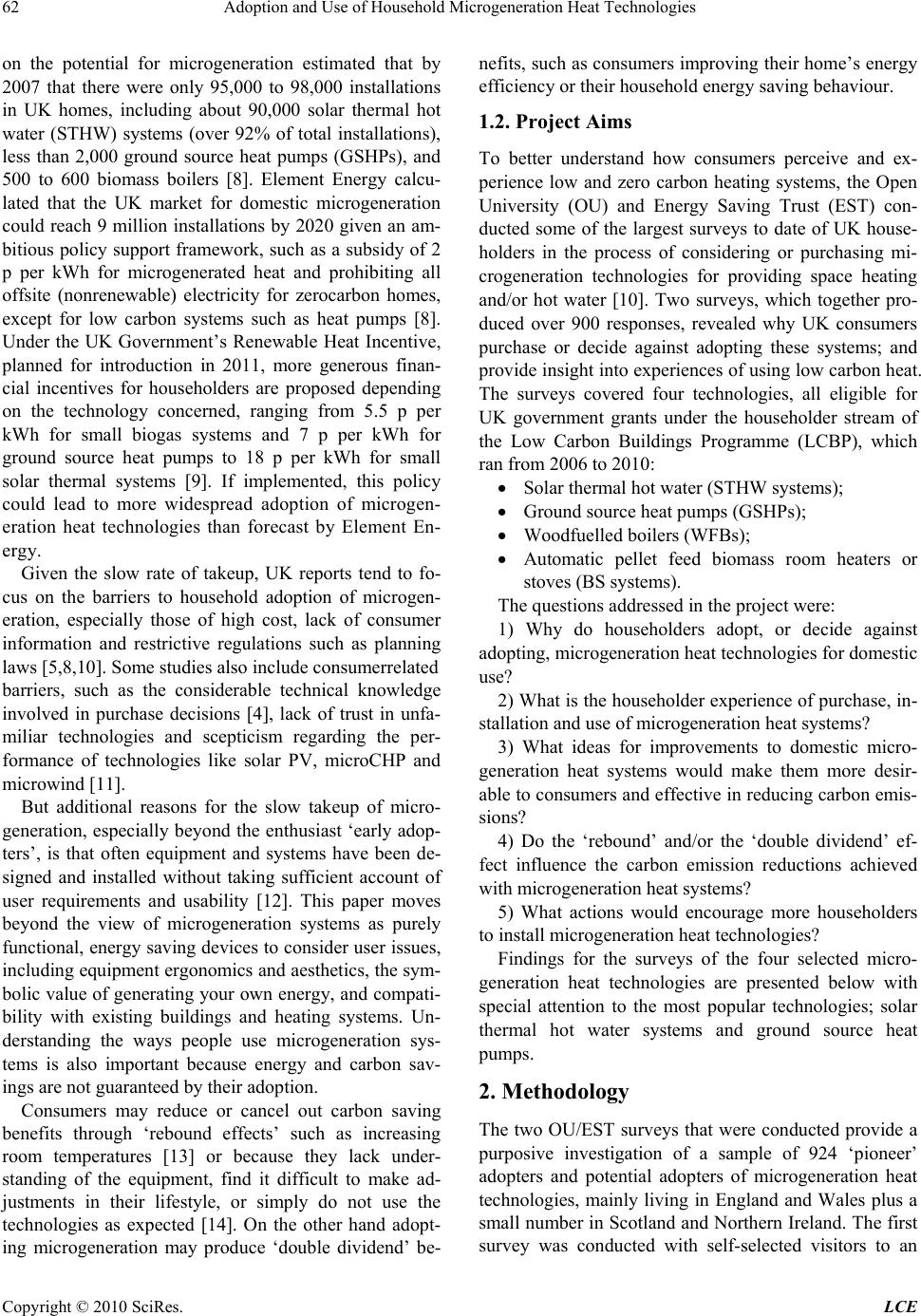 Adoption and Use of Household Microgeneration Heat Technologies Copyright © 2010 SciRes. LCE 62 on the potential for microgeneration estimated that by 2007 that there were only 95,000 to 98,000 installations in UK homes, including about 90,000 solar thermal hot water (STHW) systems (over 92% of total installations), less than 2,000 ground source heat pumps (GSHPs), and 500 to 600 biomass boilers [8]. Element Energy calcu- lated that the UK market for domestic microgeneration could reach 9 million installations by 2020 given an am- bitious policy support framework, such as a subsidy of 2 p per kWh for microgenerated heat and prohibiting all offsite (nonrenewable) electricity for zerocarbon homes, except for low carbon systems such as heat pumps [8]. Under the UK Government’s Renewable Heat Incentive, planned for introduction in 2011, more generous finan- cial incentives for householders are proposed depending on the technology concerned, ranging from 5.5 p per kWh for small biogas systems and 7 p per kWh for ground source heat pumps to 18 p per kWh for small solar thermal systems [9]. If implemented, this policy could lead to more widespread adoption of microgen- eration heat technologies than forecast by Element En- ergy. Given the slow rate of takeup, UK reports tend to fo- cus on the barriers to household adoption of microgen- eration, especially those of high cost, lack of consumer information and restrictive regulations such as planning laws [5,8,10]. Some studies also include consumerrelated barriers, such as the considerable technical knowledge involved in purchase decisions [4], lack of trust in unfa- miliar technologies and scepticism regarding the per- formance of technologies like solar PV, microCHP and microwind [1 1 ]. But additional reasons for the slow takeup of micro- generation, especially beyond the enthusiast ‘early adop- ters’, is that often equipment and systems have been de- signed and installed without taking sufficient account of user requirements and usability [12]. This paper moves beyond the view of microgeneration systems as purely functional, energy saving devices to consider user issues, including equipment ergonomics and aesthetics, the sym- bolic value of generating your own ener gy, and compati- bility with existing buildings and heating systems. Un- derstanding the ways people use microgeneration sys- tems is also important because energy and carbon sav- ings are not guaranteed by their adoption. Consumers may reduce or cancel out carbon saving benefits through ‘rebound effects’ such as increasing room temperatures [13] or because they lack under- standing of the equipment, find it difficult to make ad- justments in their lifestyle, or simply do not use the technologies as expected [14]. On the other hand adopt- ing microgeneration may produce ‘double dividend’ be- nefits, such as consumers improving their home’s energy efficiency or their household energy saving behaviour. 1.2. Project Aims To better understand how consumers perceive and ex- perience low and zero carbon heating systems, the Open University (OU) and Energy Saving Trust (EST) con- ducted some of the largest surveys to date of UK house- holders in the process of considering or purchasing mi- crogeneration technologies for providing space heating and/or hot water [10]. Two surveys, which together pro- duced over 900 responses, revealed why UK consumers purchase or decide against adopting these systems; and provide insight into experiences of using low carbon heat. The surveys covered four technologies, all eligible for UK government grants under the householder stream of the Low Carbon Buildings Programme (LCBP), which ran from 2006 to 2010: Solar thermal hot water (STHW systems); Ground source heat pumps (GSHPs); Woodfuelled boilers (WFBs); Automatic pellet feed biomass room heaters or stoves (BS systems). The questions addressed in the project were: 1) Why do householders adopt, or decide against adopting, microgeneration heat technologies for domestic use? 2) What is the householder experience of purchase, in- stallation and use of microgeneration heat systems? 3) What ideas for improvements to domestic micro- generation heat systems would make them more desir- able to consumers and effective in reducing carbon emis- sions? 4) Do the ‘rebound’ and/or the ‘double dividend’ ef- fect influence the carbon emission reductions achieved with microgeneration heat systems? 5) What actions would encourage more householders to install microgeneration heat technologies? Findings for the surveys of the four selected micro- generation heat technologies are presented below with special attention to the most popular technologies; solar thermal hot water systems and ground source heat pumps. 2. Methodology The two OU/EST surveys that were conducted provide a purposive investigation of a sample of 924 ‘pioneer’ adopters and potential adopters of microgeneration heat technologies, mainly living in England and Wales plus a small number in Scotland and Northern Ireland. The first survey was conducted with self-selected visitors to an 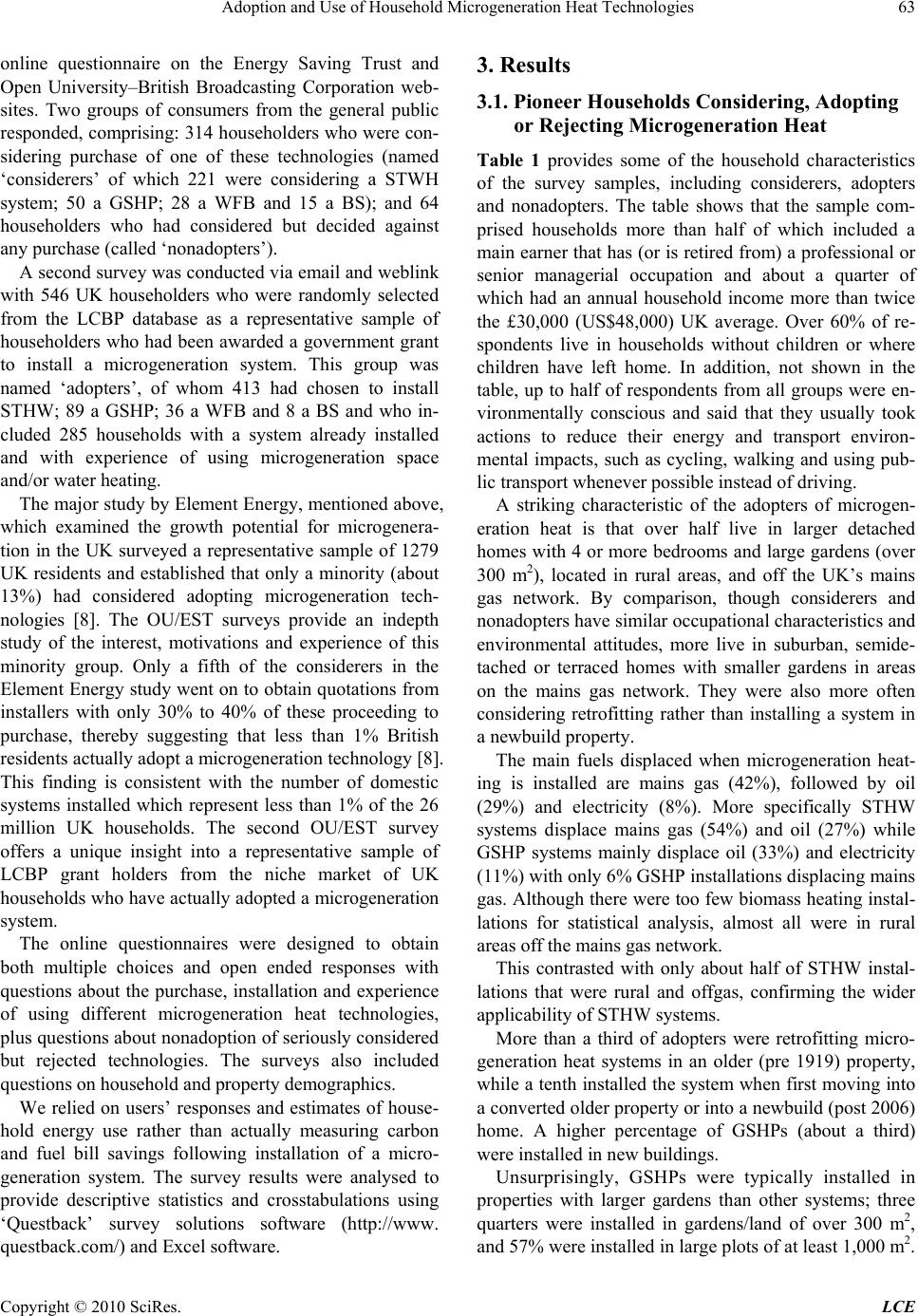 Adoption and Use of Household Microgeneration Heat Technologies Copyright © 2010 SciRes. LCE 63 online questionnaire on the Energy Saving Trust and Open University–British Broadcasting Corporation web- sites. Two groups of consumers from the general public responded, comprisin g: 314 householders who were con- sidering purchase of one of these technologies (named ‘considerers’ of which 221 were considering a STWH system; 50 a GSHP; 28 a WFB and 15 a BS); and 64 householders who had considered but decided against any purchase (called ‘nonadopters’). A second survey was conducted via email and weblink with 546 UK householders who were randomly selected from the LCBP database as a representative sample of householders who had been awarded a government grant to install a microgeneration system. This group was named ‘adopters’, of whom 413 had chosen to install STHW; 89 a GSHP; 36 a WFB and 8 a BS and who in- cluded 285 households with a system already installed and with experience of using microgeneration space and/or water heating. The major study by Element Energy, mentioned above, which examined the growth potential for microgenera- tion in the UK surveyed a representative sample of 1279 UK residents and established that only a minority (about 13%) had considered adopting microgeneration tech- nologies [8]. The OU/EST surveys provide an indepth study of the interest, motivations and experience of this minority group. Only a fifth of the considerers in the Element Energy study went on to obtain quotations from installers with only 30% to 40% of these proceeding to purchase, thereby suggesting that less than 1% British residents actually adopt a microgeneration technology [8]. This finding is consistent with the number of domestic systems installed which represent less than 1% of the 26 million UK households. The second OU/EST survey offers a unique insight into a representative sample of LCBP grant holders from the niche market of UK households who have actually adopted a microgeneration system. The online questionnaires were designed to obtain both multiple choices and open ended responses with questions about the purchase, installation and experience of using different microgeneration heat technologies, plus questions about non adoption of seriously considered but rejected technologies. The surveys also included questions on household and property demographics. We relied on users’ responses and estimates of house- hold energy use rather than actually measuring carbon and fuel bill savings following installation of a micro- generation system. The survey results were analysed to provide descriptive statistics and crosstabulations using ‘Questback’ survey solutions software (http://www. questback.com/) and Excel software. 3. Results 3.1. Pioneer Households Considering, Adopting or Rejecting Microgeneration Heat Table 1 provides some of the household characteristics of the survey samples, including considerers, adopters and nonadopters. The table shows that the sample com- prised households more than half of which included a main earner that has (or is retired from) a professional or senior managerial occupation and about a quarter of which had an annual household income more than twice the £30,000 (US$48,000) UK average. Over 60% of re- spondents live in households without children or where children have left home. In addition, not shown in the table, up to half of respondents from all groups were en- vironmentally conscious and said that they usually took actions to reduce their energy and transport environ- mental impacts, such as cycling, walking and using pub- lic transport whenever possible instead of driving. A striking characteristic of the adopters of microgen- eration heat is that over half live in larger detached homes with 4 or more bedrooms and large gardens (over 300 m2), located in rural areas, and off the UK’s mains gas network. By comparison, though considerers and nonadopters have similar occupational characteristics and environmental attitudes, more live in suburban, semide- tached or terraced homes with smaller gardens in areas on the mains gas network. They were also more often considering retrofitting rather than installing a system in a newbuild property. The main fuels displaced when microgeneration heat- ing is installed are mains gas (42%), followed by oil (29%) and electricity (8%). More specifically STHW systems displace mains gas (54%) and oil (27%) while GSHP systems mainly displace oil (33%) and electricity (11%) with only 6% GSHP installations displacing mains gas. Although there were too few biomass heating instal- lations for statistical analysis, almost all were in rural areas off the mai ns g as n et work. This contrasted with only about half of STHW instal- lations that were rural and offgas, confirming the wider applicability of STHW systems. More than a third of adopters were retrofitting micro- generation heat systems in an older (pre 1919) property, while a tenth installed the system when first moving into a converted older property or into a newbuild (post 2006) home. A higher percentage of GSHPs (about a third) were installed in new buildings. Unsurprisingly, GSHPs were typically installed in properties with larger gardens than other systems; three quarters were installed in gardens/land of over 300 m2, and 57% were installed in large plots of at least 1,000 m2. 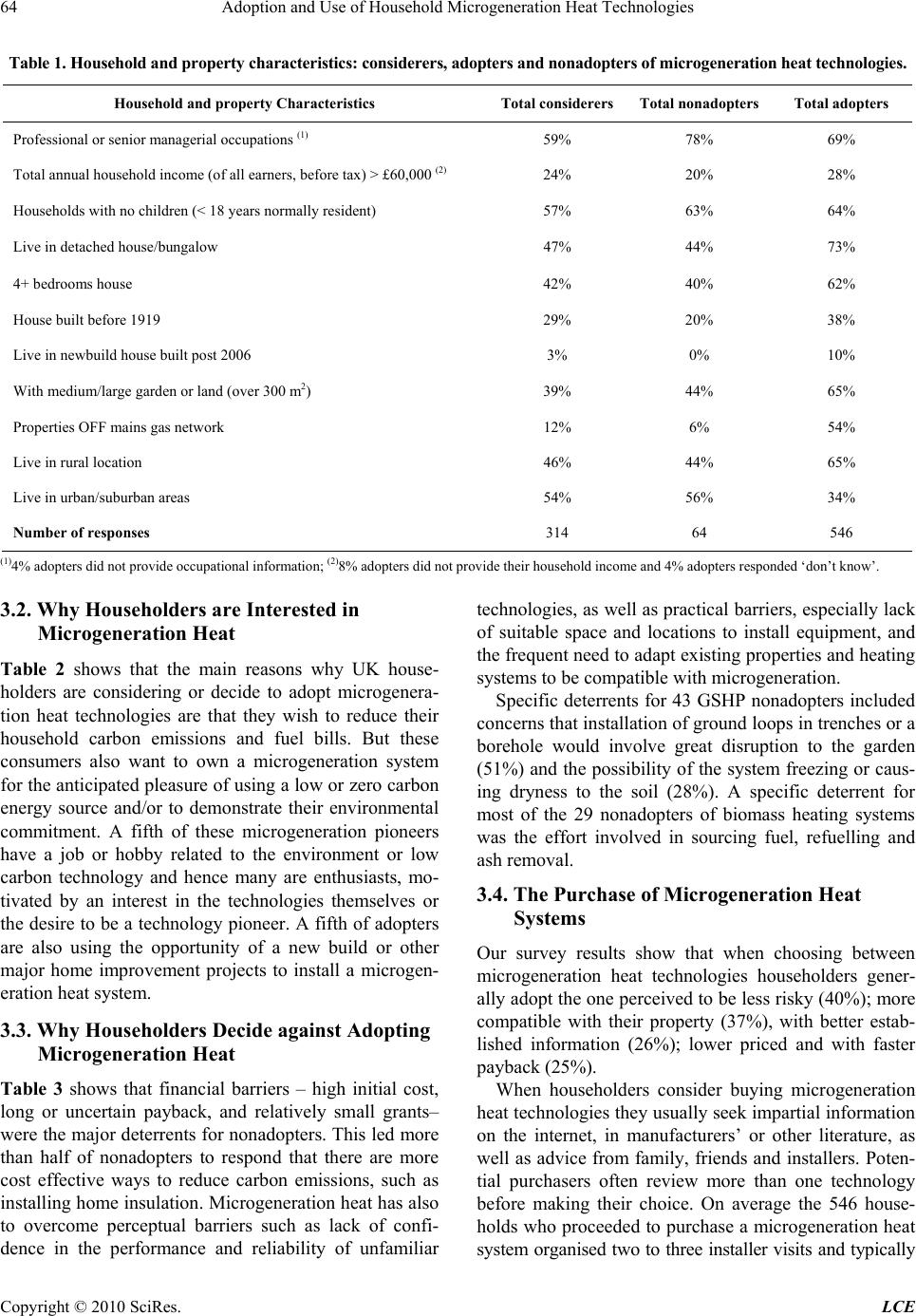 Adoption and Use of Household Microgeneration Heat Technologies Copyright © 2010 SciRes. LCE 64 Table 1. Household and property characterist ics: considerers, ad op ters an d nonadopters of microgeneration heat technologies. Household and property Characteris tics Total considerersTotal nonadopters Total adopters Professional or senior manager ial occupations (1) 59% 78% 69% Total annual household income (of all ear ners, before tax) > £60,000 (2) 24% 20% 28% Households with no children (< 18 years normally resident) 57% 63% 64% Live in detached house/bungalow 47% 44% 73% 4+ bedrooms house 42% 40% 62% House built before 1919 29% 20% 38% Live in newbuild house built post 2006 3% 0% 10% With medium/large garden or l and (over 300 m2) 39% 44% 65% Properties OFF mains gas network 12% 6% 54% Live in rural location 46% 44% 65% Live in urban/suburban ar ea s 54% 56% 34% Number of responses 314 64 546 (1)4% adopters did not provide occupational information; (2)8% adopters did not provide their household income and 4% adopters responded ‘don’t know’. 3.2. Why Householders are Interested in Microgeneration Heat Table 2 shows that the main reasons why UK house- holders are considering or decide to adopt microgenera- tion heat technologies are that they wish to reduce their household carbon emissions and fuel bills. But these consumers also want to own a microgeneration system for the anticipated pleasure of using a low or zero carbon energy source and/or to demonstrate their environmental commitment. A fifth of these microgeneration pioneers have a job or hobby related to the environment or low carbon technology and hence many are enthusiasts, mo- tivated by an interest in the technologies themselves or the desire to be a technology pioneer. A fifth of adopters are also using the opportunity of a new build or other major home improvement projects to install a microgen- eration heat system. 3.3. Why Householders Decide against Adopting Microgeneration Heat Table 3 shows that financial barriers – high initial cost, long or uncertain payback, and relatively small grants– were the major deterrents for nonadopters. This led more than half of nonadopters to respond that there are more cost effective ways to reduce carbon emissions, such as installing home insulation. Microgeneration heat has also to overcome perceptual barriers such as lack of confi- dence in the performance and reliability of unfamiliar technologies, as well as practical barriers, especially lack of suitable space and locations to install equipment, and the frequent need to ad apt existing prop erties and heating systems to be compatible with microgeneration. Specific deterrents for 43 GSHP nonadopters included concerns that in stallation of gr ound loops in trenches or a borehole would involve great disruption to the garden (51%) and the possibility of the system freezing or caus- ing dryness to the soil (28%). A specific deterrent for most of the 29 nonadopters of biomass heating systems was the effort involved in sourcing fuel, refuelling and ash removal. 3.4. The Purchase of Microgeneration Heat Systems Our survey results show that when choosing between microgeneration heat technologies householders gener- ally adopt the one perceived to be less risky (40%); more compatible with their property (37%), with better estab- lished information (26%); lower priced and with faster payback (25% ) . When householders consider buying microgeneration heat technologies they usually seek impartial information on the internet, in manufacturers’ or other literature, as well as advice from family, friends and installers. Poten- tial purchasers often review more than one technology before making their choice. On average the 546 house- holds who proceeded to purchase a microgeneration heat system organised two to three installer visits and typically 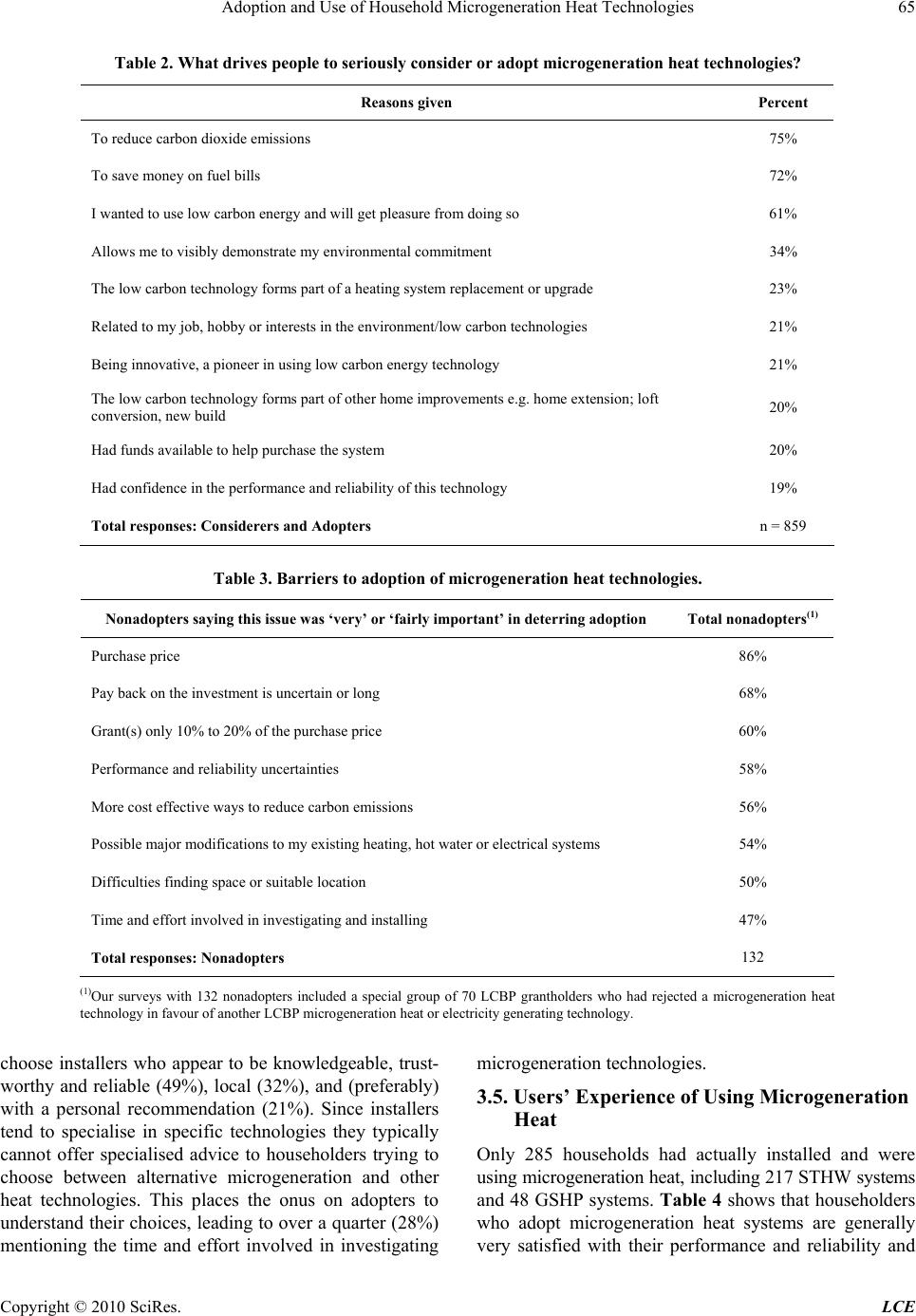 Adoption and Use of Household Microgeneration Heat Technologies Copyright © 2010 SciRes. LCE 65 Table 2. What drives people to seriously consider or adopt microgeneration heat technologies? Reasons given Percent To reduce carbon dioxide emissions 75% To save money on fuel bills 72% I wanted to use low carbon energy and will get pleasure from doing so 61% Allows me to visibly demonstrate my environmental commitment 34% The low carbon technology forms part of a heating system replacement or upgrade 23% Related to my job, hobby or interests in the environment/low carbon technologies 21% Being innovative, a pioneer in u sing low carbon energy technology 21% The low carbon technology forms part of other home improvements e.g. home extension; loft conversion, new build 20% Had funds available to help purchase the system 20% Had confidence in the performa nc e and reliabil ity of this technology 19% Total responses: Considerers and Adopters n = 859 Table 3. Barriers to adoption of microgeneration heat technologies. Nonadopters saying this issue was ‘very’ or ‘fairly important’ in deterring adoption Total nonadopters(1) Purchase price 86% Pay back on the investment is uncertain or long 68% Grant(s) only 10% to 20% of the purchase price 60% Performance and reliability u n c e r tainti e s 58% More cost effective ways to red uce carbon emissions 56% Possible major modifications to my existing heating, hot water or electrical systems 54% Difficulties finding space or suitabl e location 50% Time and effort involved in investigating and installing 47% Total responses: Nonadopters 132 (1)Our surveys with 132 nonadopters included a special group of 70 LCBP grantholders who had rejected a microgeneration heat technology in favour of another LCBP microgeneration heat or electricity generating technology. choose installers who appear to be knowledgeable, trust- worthy and reliable (49%), local (32%), and (preferably) with a personal recommendation (21%). Since installers tend to specialise in specific technologies they typically cannot offer specialised advice to householders trying to choose between alternative microgeneration and other heat technologies. This places the onus on adopters to understand their choices, leading to over a quarter (28%) mentioning the time and effort involved in investigating microgeneration technologies. 3.5. Users’ Experience of Using Microgeneration Heat Only 285 households had actually installed and were using microgeneration heat, including 217 STHW systems and 48 GSHP systems. Table 4 shows that householders who adopt microgeneration heat systems are generally very satisfied with their performance and reliability and  Adoption and Use of Household Microgeneration Heat Technologies Copyright © 2010 SciRes. LCE 66 Table 4. Adopters’ satisfaction using microgeneration heat system. Satisfaction indicator(1) Total adopters with experience of use(2) STHW adopters GSHP adopters System meets household demands for heating and/or hot water 74% agree 3% disagree 71% agree 3% disagree 83% agree 2% disagree System performs reliably 86% agree 3% disagree 88% agree 2% disagree 85% agree 0% disagree Get pleasure from using low carbon energy 92% agree 0% disagree 93% agree 0% disagree 87% agree 0% disagree Satisfactory appearance 87% agree 3% disagree 86% agree 1% disagree 94% agree 4% disagree Satisfactory instructions on operat ing and using system 64% agree 6% disagree 65% agree 6% disagree 52% agree 8% disagree Controls provide feedback on efficient system use 44% agree 20% disagree 47% agree 19% disagree 30% agree 30% disagree Satisfactory costs of running and m a intaining t he system 70% agree 2% disagree 72% agree 0% disagree 58% agree 6% disagree Reductions in fuel bills are as expected 46% agree 4% disagree 47% agree 3% disagree 40% agree 6% disagree Total responses 285 217 48 (1)‘agree’ and ‘dis agree’ resp onses incl ude stron gly agree/s trongly d isagree. (2)responses from 15 woodfuelled boiler adopters and 5 biomass stove adopters are included in the total. 92% say they get considerable pleasure from using low carbon heat. However, less than half of all users (46%) said that the reductions in their fu el bills were as great as expected (although this was before major fuel price rises in the UK). Not s hown in the table is the res ult that many of the se adopters (59%) required unexpected modifications to their existing heating and hot water system during in stal- lation. This particularly affected twothirds (67%) of STHW adopters, while twothirds (69%) of GSHP adopt- ers complained about the disruption to their property or garden during i nstal l a t i on. A small percentage (12%) of all users complained th at their system provided less than expected of their house- hold’s heating and/or hot water requirements. A few GSHP adopters (10%) also complained about the slow warmup of their heating and/or inability to heat rooms to the required temperature. GSHPs produce lower flow temperatures than a boiler and so response times can be slow. A specific complaint, made by a third (32%) of STHW users, is disappointment at not being able to use solar- heated water in their coldfill washing machine and/or dishwasher. This problem may be attributed to plumbing constraints or modern coldfill only appliances. It appears that the adapter valves available in Germany and else- where to allow use of solar heated water in coldfill ap- pliances are not supplied by UK installers. The most common problems experienced by over a third of all users was uncertainty about how best to oper- ate the system to make most efficient use of fuel or en- ergy (37%) and difficulties understanding the system’s controls (28%). Table 4 shows that less than half of the users are satisfied with the feedback they get from the system’s controls on the energy and money they are sav- ing, and a fifth are strongly dissatisfied. Poor usability was a particular problem for GSHP users, with nearly one third of them very dissatisfied with feedback pro- vided by their system’s often sophisticated and comput- erised controls. 3.6. Users’ Ideas for Improving Microgeneration Heat The main system improvements desired by microgenera- tion heat adopters arose from the problems they experi- enced in use. The improvements include more user- friendly controls, better instructions on use of controls, and improved feedback displays showing energy gener- ated and carbon and money saved. This would help users understand how to make the most efficient use of fuel and maximise carbon and financial savings. Adopters would also like improvements to the compatibility of microgeneration techno logies with ex isting build ings and heating systems. Over half (57%) of 413 STHW adopters would like systems improved to provide space heating as well as hot water, probably not realising that such systems are available but are not usually cost-effective in the UK  Adoption and Use of Household Microgeneration Heat Technologies Copyright © 2010 SciRes. LCE 67 climate. Nearly half (48%) wanted easier to understand STHW controls that minimise backup water heating use and provide feedback on money and energy savings. Over half 89 GSHP adopters (53%) would like con- trols that give more feedback on operating efficiency (e.g. electrical energy in and heat energy out) and energy saved – rather like a car computer. Almost a quarter would like higher heat pump efficiencies with existing radiator and hot w ater systems (24%), and more compact designs for ground collectors (22%) to allow GSHPs to be installed in smaller house sites. Nearly half (44%) of the woodfuelled boiler (WFB) system adopters would like more compact designs matched to smaller homes and 17% would like automatic fuelling and ash removal. Most of the au tomatic biomass stove (BS) adopters would like improvements to the in- frastructure to provide a reliable supply of fuel pellets. However, with samples of only 36 adopters of WFB and 8 BS systems, these desired improvements are only in- dicative. 3.7. Carbon Reductions with Microgeneration Heat Although over threequarters of adopters say their system meets their heating and hot water needs, as noted in Ta- ble 4 only 46% were satisfied that their fuel bills have reduced much as expected. This questions whether these technologies are performing as well as designed. When asked if the installation of a low carbon energy system had led to changes in home energy use some us- ers described ‘rebound’ effects. Thus a quarter of 272 users admitted that they were heating more of the home and/or for longer periods, and 8% said they used more hot water. But most users responded that they were not heating rooms to higher temperatures or using more hot water. However, there was also some evidence of ‘double dividends’ or additional carbon reductions that followed installation of a microgeneration system, including in- creased general household energy awareness and adop- tion of additional home energy efficiency measures. Three quarters of 272 microgeneration users said that they are more aware of their energy use, make greater efforts to save energy than before the installation, and have adapted their patterns of use of space heating and/or hot water to make most efficient use of the system. The findings also show that although most of the 546 adopters had already installed energy efficiency meas- ures before applying for a LCBP grant to help pay for the system, the grant stimulated up to a quarter of adopters to install extra insulation, new energy-saving lights and/or heating controls. A fifth of all adopters went further and installed additional energy saving measures over and above the grant’s requirements, including underfloor insulation (13%); hot water cylinder thermostats (19%); A-rated domestic appliances (10%); and low-emissivity double glazing (10%), while 2% also installed solar PV. 3.8. Encouraging UK Householders to Adopt Microgeneration Heat Reducing the initial cost of microgeneration heat systems, thus addressing the biggest barrier to adoption, is proba- bly the main way of widening appeal. Our survey found price thresholds below which many more microgenera- tion considerers and nonadopters said they would proba- bly purchase a system. For example, £2500 to £3,000 was the maximum most microgeneration considerers were prepared to pay for a retrofit STHW system, rather than the £4000 average price in the UK. The maximum price threshold for those considering a GSHP installation was about £10,000, while many GSHP systems cost more than that to install. Other than directly reducing the price, the most popu- lar financial support measure for microgeneration is local council tax relief following system installation; favoured by over half of all respondents (53%), while the least popular measure was lowcost, long term loans for pur- chase, favoured by on ly 18%. Over two-thirds of all respondents would support new building regulations that required householders in the UK, as in some other countries, to install low carbon energy technologies when undertaking major refurbishments, extensions or conv ersions to their home. Increasing consumer understanding and confidence in microgeneration technologies is also needed to promote wider adoption. Table 5 shows some of the information and advice measures and support wanted by consumers to help with the complex process of choosing and in- stalling a system. 4. Conclusions The UK microgeneration heat market is still at the early phase of the adoption curve with significant barriers to widespread market penetration [8]. The OU/EST surveys show that microgeneration space and water heating sys- tems currently mainly attracts ‘pioneers’ interested in innovative green technolog ies and ab le to pay the upfro nt installation costs, who are also driven by a desire to re- duce their carbon emissions coupled with the hope to save money and enjoy the pleasure of using low or zero carbon energy. These findings reinforce our previous research on the drivers for UK consumer adoption of household renewables [15], as well as that of similar re- search in Germany, Austria, Australia and the USA [16-18]. Our surveys identify those considering or adopt- ing microgeneration – estimated to be limited to about 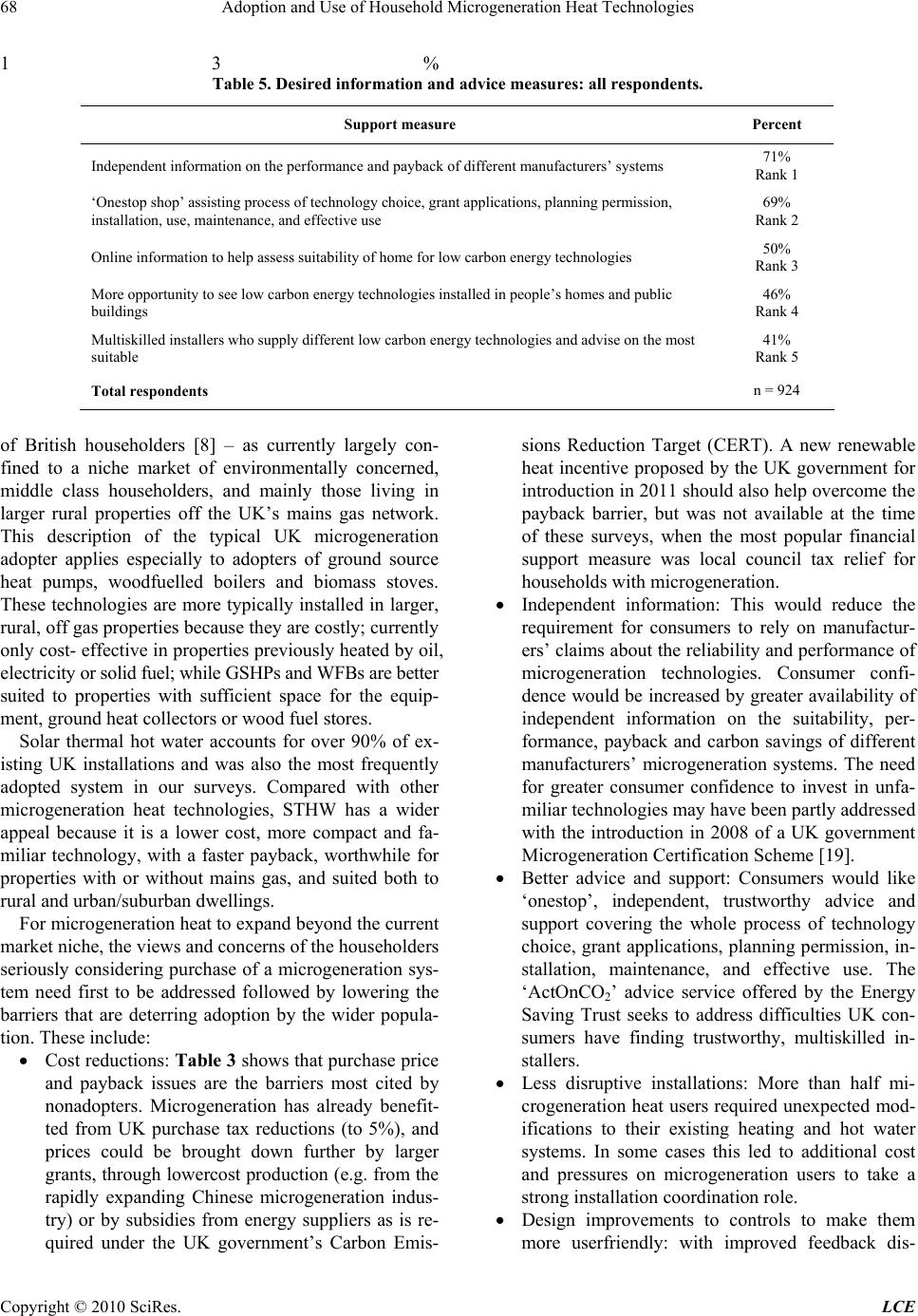 Adoption and Use of Household Microgeneration Heat Technologies Copyright © 2010 SciRes. LCE 68 13% Table 5. Desired information and advice measures: all respondents. Support measure Percent Independent information on the performance and payback of dif ferent manufacturers’ systems 71% Rank 1 ‘Onestop shop’ assisting process of technology choice, grant application s, planning permission, installation, use, mainte nance, and effective use 69% Rank 2 Online informati on to help ass e ss su i ta b il i ty of home for low carbon energy technologies 50% Rank 3 More opportunity to see low carbon energy technologies installed in people’s homes and public buildings 46% Rank 4 Multiskilled installers who suppl y different low carbon energy technologies and advise on the most suitable 41% Rank 5 Total respondents n = 924 of British householders [8] – as currently largely con- fined to a niche market of environmentally concerned, middle class householders, and mainly those living in larger rural properties off the UK’s mains gas network. This description of the typical UK microgeneration adopter applies especially to adopters of ground source heat pumps, woodfuelled boilers and biomass stoves. These technologies are more typically installed in larger, rural, off gas pr op erties b ecause th ey are costly; curren tly only cost- effective in properties previously heated by oil, electricity o r solid fuel; wh ile GS HPs a n d WFB s are b ette r suited to properties with sufficient space for the equip- ment, ground heat collector s or wood fuel stores. Solar thermal hot water accounts for over 90% of ex- isting UK installations and was also the most frequently adopted system in our surveys. Compared with other microgeneration heat technologies, STHW has a wider appeal because it is a lower cost, more compact and fa- miliar technology, with a faster payback, worthwhile for properties with or without mains gas, and suited both to rural and urban/ sub ur ban dwellings. For microgeneration heat to ex pand beyond the curren t market niche, the views and concerns of the householders seriously considering purchase of a microgeneration sys- tem need first to be addressed followed by lowering the barriers that are deterring adoption by the wider popula- tion. These inc l ude: Cost reductions: Table 3 shows that pu rchase price and payback issues are the barriers most cited by nonadopters. Microgeneration has already benefit- ted from UK purchase tax reductions (to 5%), and prices could be brought down further by larger grants, throug h lowercost production (e.g. from the rapidly expanding Chinese microgeneration indus- try) or by subsidies from energy suppliers as is re- quired under the UK government’s Carbon Emis- sions Reduction Target (CERT). A new renewable heat incentive proposed by the UK government for introduction in 2011 sh ould also help overco me the payback barrier, but was not available at the time of these surveys, when the most popular financial support measure was local council tax relief for households wi t h microgenerati on. Independent information: This would reduce the requirement for consumers to rely on manufactur- ers’ claims about the reliability and performance of microgeneration technologies. Consumer confi- dence would be in creased by greater availability of independent information on the suitability, per- formance, payback and carbon savings of different manufacturers’ microgeneration systems. The need for greater consumer confidence to invest in unfa- miliar technologies may have been partly addressed with the introduction in 2008 of a UK government Microgeneration Certification Scheme [19]. Better advice and support: Consumers would like ‘onestop’, independent, trustworthy advice and support covering the whole process of technology choice, grant applications, planning permission, in- stallation, maintenance, and effective use. The ‘ActOnCO2’ advice service offered by the Energy Saving Trust seeks to address difficulties UK con- sumers have finding trustworthy, multiskilled in- stallers. Less disruptive installations: More than half mi- crogeneration heat users required unexpected mod- ifications to their existing heating and hot water systems. In some cases this led to additional cost and pressures on microgeneration users to take a strong installation coordination role. Design improvements to controls to make them more userfriendly: with improved feedback dis- 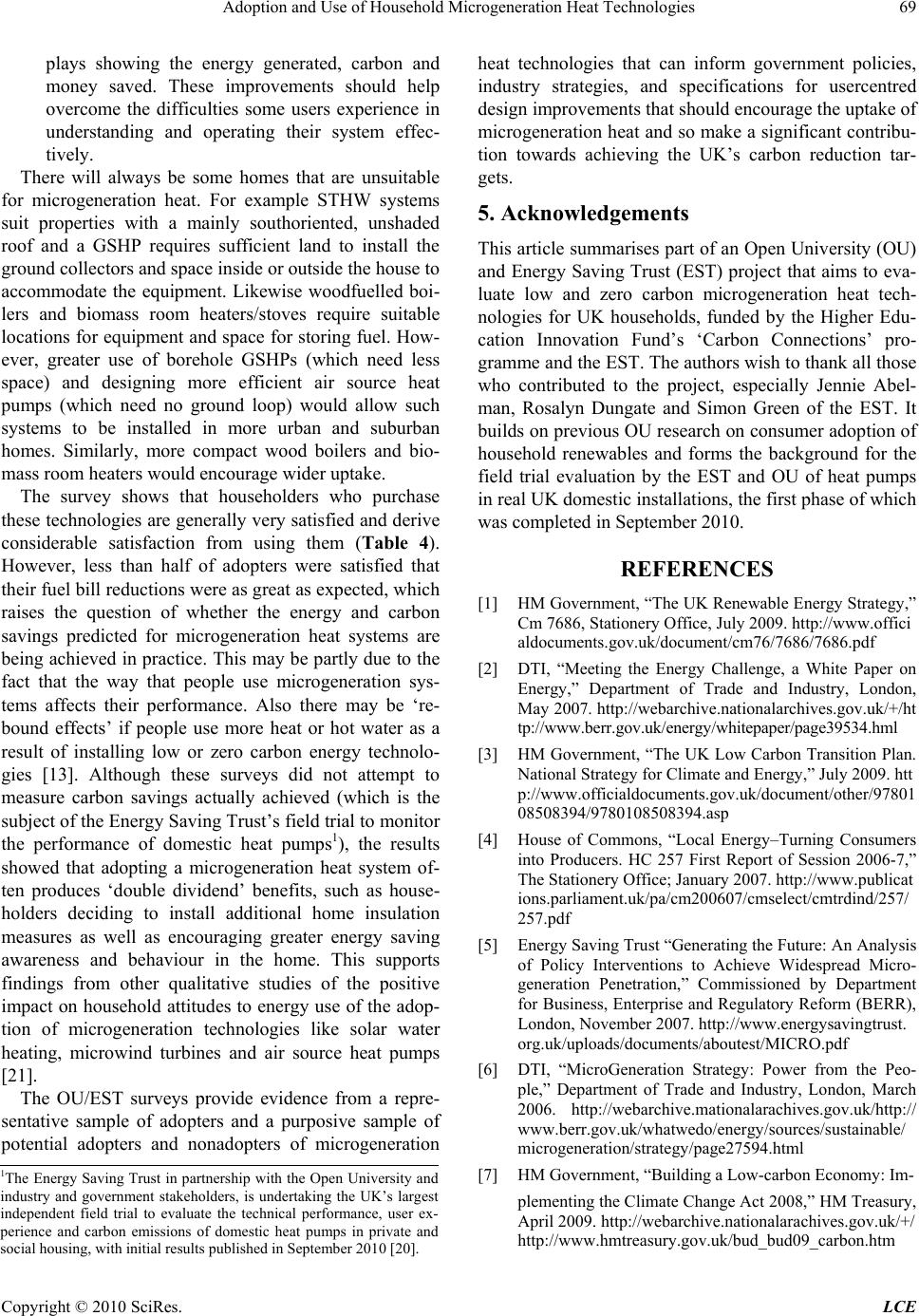 Adoption and Use of Household Microgeneration Heat Technologies Copyright © 2010 SciRes. LCE 69 plays showing the energy generated, carbon and money saved. These improvements should help overcome the difficulties some users experience in understanding and operating their system effec- tively. There will always be some homes that are unsuitable for microgeneration heat. For example STHW systems suit properties with a mainly southoriented, unshaded roof and a GSHP requires sufficient land to install the ground collectors and space inside or outside the house to accommodate the equipment. Likewise woodfuelled boi- lers and biomass room heaters/stoves require suitable locations for equipment and space for storing fuel. How- ever, greater use of borehole GSHPs (which need less space) and designing more efficient air source heat pumps (which need no ground loop) would allow such systems to be installed in more urban and suburban homes. Similarly, more compact wood boilers and bio- mass room heaters would encourage wider uptake. The survey shows that householders who purchase these technologies are generally very satisfied and derive considerable satisfaction from using them (Table 4). However, less than half of adopters were satisfied that their fuel bill reductions were as great as expected , which raises the question of whether the energy and carbon savings predicted for microgeneration heat systems are being achieved in practice. This may be partly due to the fact that the way that people use microgeneration sys- tems affects their performance. Also there may be ‘re- bound effects’ if people use more heat or hot water as a result of installing low or zero carbon energy technolo- gies [13]. Although these surveys did not attempt to measure carbon savings actually achieved (which is the subject of the Energy Saving Trust’s field trial to monitor the performance of domestic heat pumps1), the results showed that adopting a microgeneration heat system of- ten produces ‘double dividend’ benefits, such as house- holders deciding to install additional home insulation measures as well as encouraging greater energy saving awareness and behaviour in the home. This supports findings from other qualitative studies of the positive impact on household attitudes to energy use of the adop- tion of microgeneration technologies like solar water heating, microwind turbines and air source heat pumps [21]. The OU/EST surveys provide evidence from a repre- sentative sample of adopters and a purposive sample of potential adopters and nonadopters of microgeneration heat technologies that can inform government policies, industry strategies, and specifications for usercentred design improvements that should encourage the uptake of microgeneration heat and so make a significant contribu- tion towards achieving the UK’s carbon reduction tar- gets. 5. Acknowledgements This article summarises part of an Open University (OU) and Energy Saving Trust (EST) project that aims to eva- luate low and zero carbon microgeneration heat tech- nologies for UK households, funded by the Higher Edu- cation Innovation Fund’s ‘Carbon Connections’ pro- gramme and the EST. The authors wish to thank all those who contributed to the project, especially Jennie Abel- man, Rosalyn Dungate and Simon Green of the EST. It builds on previous OU research on consumer adoption of household renewables and forms the background for the field trial evaluation by the EST and OU of heat pumps in real UK domestic installations, the first phase of which was completed in September 2010. REFERENCES [1] HM Government, “The UK Renewable Ener gy Strate gy,” Cm 7686, Stationery Office, July 2009. http://www.offici aldocuments.gov.uk/document/cm76/7686/7686.pdf [2] DTI, “Meeting the Energy Challenge, a White Paper on Energy,” Department of Trade and Industry, London, May 2007. http://webarchive.nationalarchives.gov.uk/+/ht tp://www.berr.gov.uk/energy/whitepaper/page39534.hml [3] HM Government, “The UK Low Carbon Transition Plan. National Strategy for Climate and Energy,” July 2009. htt p://www.officialdocuments.gov.uk/document/other/97801 08508394/9780108508394.asp [4] House of Commons, “Local Energy–Turning Consumers into Producers. HC 257 First Report of Session 2006-7,” The Stationery Office; January 200 7. http://www .publ icat ions.parliament.uk/pa/cm200607/cmselect/cmtrdind/257/ 257.pdf [5] Energy Saving Trust “Generating the Future: An Analysis of Policy Interventions to Achieve Widespread Micro- generation Penetration,” Commissioned by Department for Business, Enterprise and Regulatory Reform (BERR), London, November 2007. http://www.energysavingtrust. org.uk/uploads/documents/aboutest/MICRO.pdf [6] DTI, “MicroGeneration Strategy: Power from the Peo- ple,” Department of Trade and Industry, London, March 2006. http://webarchive.mationalarachives.gov.uk/http:// www.berr.gov.uk/whatwedo/energy/sources/sustainable/ microgeneration/strategy/page27594.html [7] HM Government, “Building a Low-carbon Eco n omy: Im- plementing the Climate Change Act 2008,” HM Treasury, April 2009. http://webarchive.nationalarachives.gov.uk/+/ http://www.hmtreasury.gov.uk/bud_bud09_carbon.htm 1The Energy Saving Trust in partnership with the Open University and industry and government stakeholders, is undertaking the UK’s largest independent field trial to evaluate the technical performance, user ex- p erience and carbon emissions of domestic heat pumps in private and social housing, with init ial results published in September 2010 [20]. 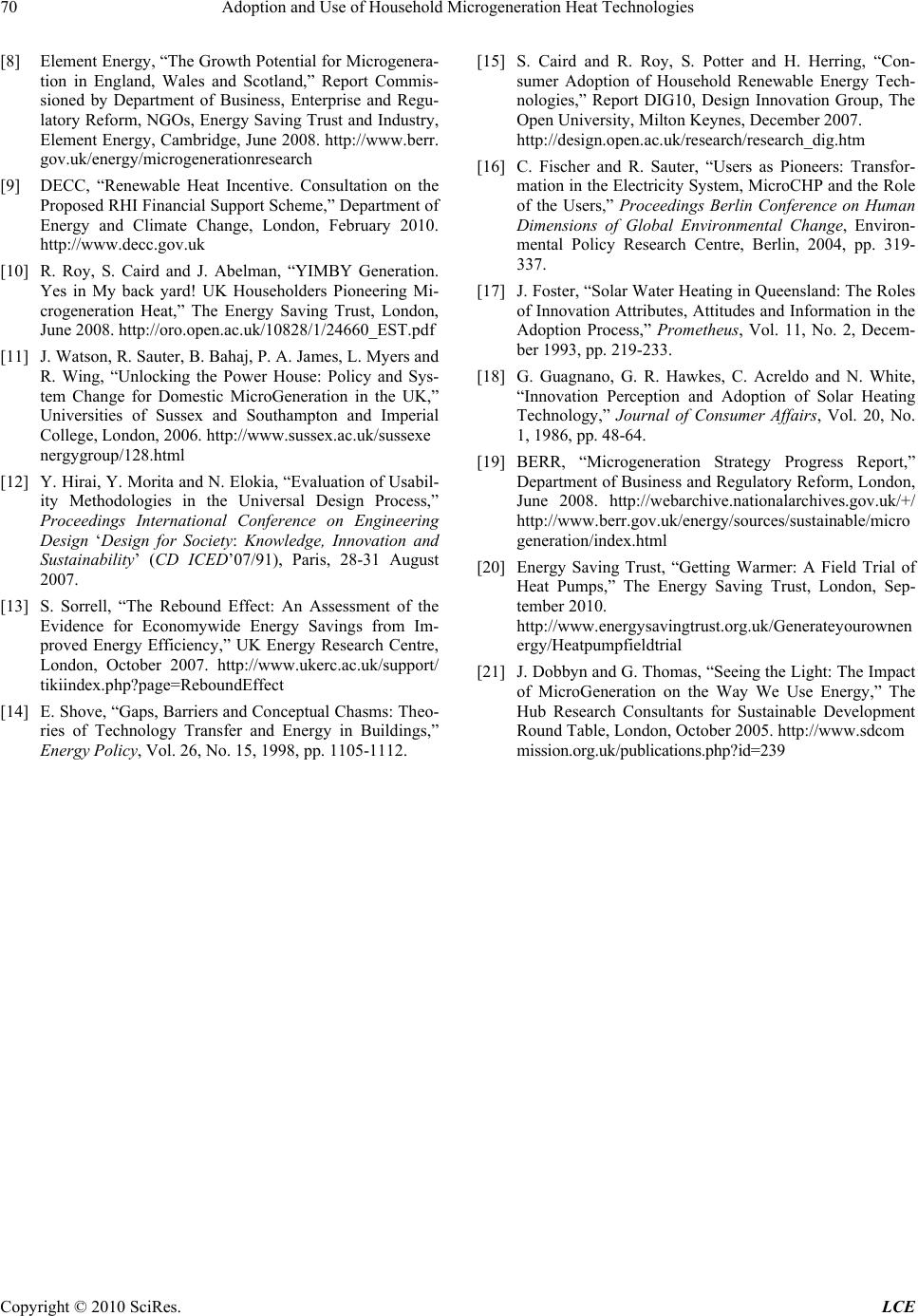 Adoption and Use of Household Microgeneration Heat Technologies Copyright © 2010 SciRes. LCE 70 [8] Element Energy, “The Growth Potential for Microgenera- tion in England, Wales and Scotland,” Report Commis- sioned by Department of Business, Enterprise and Regu- latory Reform, NGOs, Energy Saving Trust and Industry, Element Energy, Cambridge, June 2008. http://www.berr. gov.uk/energy/microgenerationresearch [9] DECC, “Renewable Heat Incentive. Consultation on the Proposed RHI Financial Support Scheme,” Department of Energy and Climate Change, London, February 2010. http://www.decc.gov.uk [10] R. Roy, S. Caird and J. Abelman, “YIMBY Generation. Yes in My back yard! UK Householders Pioneering Mi- crogeneration Heat,” The Energy Saving Trust, London, June 2008. http://oro.open.ac.uk/10828/1/24660_EST.pdf [11] J. Watson, R. Sauter, B. Bahaj, P. A. James, L. Myers and R. Wing, “Unlocking the Power House: Policy and Sys- tem Change for Domestic MicroGeneration in the UK,” Universities of Sussex and Southampton and Imperial College, London, 2006. http://www.sussex.ac.uk/sussexe nergygroup/128.html [12] Y. Hirai, Y. Morita and N. Elokia, “Evaluation of Usabil- ity Methodologies in the Universal Design Process,” Proceedings International Conference on Engineering Design ‘Design for Society: Knowledge, Innovation and Sustainability’ (CD ICED’07/91), Paris, 28-31 August 2007. [13] S. Sorrell, “The Rebound Effect: An Assessment of the Evidence for Economywide Energy Savings from Im- proved Energy Efficiency,” UK Energy Research Centre, London, October 2007. http://www.ukerc.ac.uk/support/ tikiindex.php?page=ReboundEffect [14] E. Shove, “Gaps, Barriers and Conceptual Chasms: Theo- ries of Technology Transfer and Energy in Buildings,” Energy Policy, Vol. 26, No. 15, 1998, pp. 1105-1112. [15] S. Caird and R. Roy, S. Potter and H. Herring, “Con- sumer Adoption of Household Renewable Energy Tech- nologies,” Report DIG10, Design Innovation Group, The Open University, Milton Keynes, December 2007. http://design.open.ac.uk/research/research_dig.htm [16] C. Fischer and R. Sauter, “Users as Pioneers: Transfor- mation in the Electricity System, MicroCHP and the Role of the Users,” Proceedings Berlin Conference on Human Dimensions of Global Environmental Change, Environ- mental Policy Research Centre, Berlin, 2004, pp. 319- 337. [17] J. Foster, “Solar Water Heating in Queensland: The Roles of Innovation Attributes, Attitudes and Information in the Adoption Process,” Prometheus, Vol. 11, No. 2, Decem- ber 1993, pp. 219-233. [18] G. Guagnano, G. R. Hawkes, C. Acreldo and N. White, “Innovation Perception and Adoption of Solar Heating Technology,” Journal of Consumer Affairs, Vol. 20, No. 1, 1986, pp. 48-64. [19] BERR, “Microgeneration Strategy Progress Report,” Department of Business and Regulatory Reform, London, June 2008. http://webarchive.nationalarchives.gov.uk/+/ http://www.berr.gov.uk/energy/sources/sustainable/micro generation/index.html [20] Energy Saving Trust, “Getting Warmer: A Field Trial of Heat Pumps,” The Energy Saving Trust, London, Sep- tember 2010. http://www.energysavingtrust.org. uk/Generateyourownen ergy/Heatpumpfieldtrial [21] J. Dobbyn and G. Thomas, “Seeing the Light: The Impact of MicroGeneration on the Way We Use Energy,” The Hub Research Consultants for Sustainable Development Round Table, London, October 2005. http://www.sdcom mission.org.uk/publications.php?id=239 |

